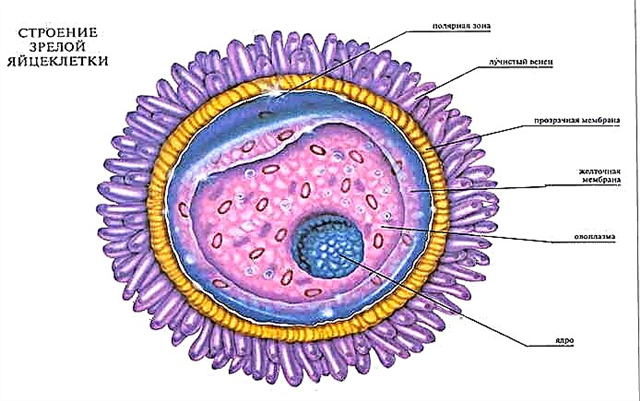
The appearance of brown discharge in the middle of the menstrual cycle cannot but alarm women, because everyone knows that there should be no blood in the discharge in the interval between menstruation. However, the reproductive functioning of the female body has its own nuances, and sometimes such discharge can be a variant of the norm.

General information
Monitoring the nature of the discharge is recommended for all women, because this allows not only planning pregnancy and contraceptive measures, but also in time to notice the earliest signs of possible female pathologies. Throughout the entire menstrual cycle, a woman goes through several phases.
- Follicular phase - begins after menstruation. Under the action of the FSH hormone, follicles begin to mature in the ovaries, one of several remains, dominant (sometimes two), and it is he who grows most actively, while the rest slow down in development.
- Ovulation - the level of estrogen rises, which gives an impetus to the active production of luteinizing hormone (LH), under the influence of which the follicular membranes become thinner and torn. The oocyte leaves the space inside the vesicle, exits and ends up in the fallopian tube, where fertilization is possible. The release process takes about an hour, the viability of the egg is limited to 24-36 hours.
- Luteal phase - at the site of rupture of the follicle on the surface of the ovary, a temporary gland (corpus luteum) is formed, producing progesterone, which supports the onset of pregnancy, if conception has taken place.
If there was no conception, then a few days before the end of the cycle, the corpus luteum dies, the level of progesterone decreases, the level of estrogen rises, and menstruation begins.

This scenario usually goes through each menstrual cycle of a healthy woman. The cervix is especially sensitive to the influence of hormones. That is why the secretions during the three phases of the cycle cannot remain the same. The cervical canal, located inside the cervix, constantly produces fluid. In the follicular phase, there is little of it, its task is to protect the genital tract and the uterine cavity from the penetration of bacteria, viruses and fungi from the vagina.
Under the influence of estrogen and LH, the cervical canal before ovulation begins to actively secrete mucus in 2-3 days. These secretions are called ovulation, they are entrusted not only with protective functions, but also with the task of reducing the acidity of the vagina (due to its own alkaline environment), as well as promoting the conduction of male germ cells. So the female body increases the likelihood of procreation - this is a mechanism of reproduction conceived by nature.
The nature of ovulatory discharge
A couple of days before the release of the oocyte, the amount of excretions increases 2-3 times: they are normally transparent, without impurities, with a characteristic feature - ductility. The viscosity of the secretions is such that they are easy to stretch between the fingers - they stretch for several centimeters. For this quality, ovulation is often compared to raw egg white. The outward resemblance is indeed strikingly great.
Additionally, women feel increased sexual desire, there may be a slight enlargement of the mammary glands, as well as an increased sensitivity of the nipples. Women with low pain tolerance have complaints of pain in the right or left side in the lower abdomen - in the area of the ovulating ovary.
Normally, the composition of secretions during ovulation contains glycoproteins, minerals, water, enzymes and carbohydrates. There are a small number of leukocytes, but erythrocytes (blood cells) in the secretions in the middle of the cycle, when a mature egg is released, should not be present. Perfectly.


But the body is not a machine, it cannot work according to the programmed average statistical data, and therefore sometimes during ovulation, discharge occurs with a small number of red blood cells. Where do they come from? From the follicle, more precisely, from the blood vessels that fed its membrane before rupture.
When the follicular vesicle membrane breaks, blood vessels also suffer. A small amount of blood from them, together with the fluid filling the vial, enters the abdominal cavity, and theoretically can come out naturally (through the vagina) within a few hours after the follicle rupture. This is perhaps the only harmless reason for the appearance of brownish, abundant discharge or discharge of pink color with brown blotches on the day of ovulation and within 1-2 days after it.
Important! This symptom should not be repeated from cycle to cycle. Usually, the appearance of light brown discharge is considered normal only if a large, tense follicle is perforated. The appearance of monthly brown discharge in the middle of the cycle is an alarming sign that can indicate various problems.

Possible reasons
A brown discharge during ovulation is much less likely to be normal than pathological. Therefore, you should not engage in self-diagnosis. If such discharge is repeated for 2-3 cycles in a row, you should consult a gynecologist and undergo an examination.
The presence of a brown or brownish color in the secretion of the cervix and vagina indicates that there are erythrocytes in the secretions that have left the blood vessels for a long time, the bleeding is not fresh, the blood clotted... Therefore, the discharge of such a plan, but after ovulation (after 1-2 days), is considered more favorable, because they have a physiological explanation - trauma of small blood vessels of the follicular membrane.
If the discharge is brown or brownish (the nuances of the shade are important, but not at the first stage of determining the causes), one should assume intermenstrual bleeding is a common pathology, which most often indicates that a woman has a hormonal disorder.
The very systematic appearance of such secretions may be an indirect sign of anovulation - a state of endocrine infertility, in which ovulation does not occur, conception is impossible.

Here are just some of the possible causes of breakthrough bleeding:
- imbalance in sex steroids (estrogen deficiency or estrogen excess);
- the woman has an installed intrauterine device;
- hormonal disruption of the cycle due to the intake of certain hormonal agents, as well as within 2-3 cycles after the abolition of oral contraceptives;
- failure of the endocrine background due to abortion, miscarriage, cleaning (2-3 cycles are required for recovery);
- endometrial polyps, endometrial hyperplasia;
- inflammatory and infectious diseases of the reproductive organs.
You need to understand that the likelihood of a change in hormonal levels can be affected by a huge variety of factors, for example, a sharp weight loss or weight gain, a trip in which a woman had to fly and change the time and climatic zone.
Even an acute respiratory viral infection or a cold with an increase in body temperature may well become the reason for the absence of ovulation in the current cycle, and the cause of intermenstrual breakthrough bleeding.


If the cause of the failure lies in a change in lifestyle, lack of sleep, chronic stress, fatigue, then it will be enough to restore normal hormonal levels and the menstrual cycle eliminate negative factors that influenced the fluctuation in the level of sex hormones. In other cases, the condition is treated hormonal drugs, the exact dosage and regimens are chosen by the doctor after the examination.
Pay attention to the amount of discharge and additional symptoms. Abundant brownish, brown discharge, mucus clots with blood streaks on the day of ovulation can be signs of serious pathologies: from cervical erosion and genital infections to malignant neoplasms of the reproductive system.
Another reason for brown mucus during the period in which a woman suspects she is about to ovulate may lie in an injury to the cervix. This is possible with excessively hard sex, with unsuccessful douching. It is advisable to visit a doctor to examine the cervix if the bleeding does not stop after 2-3 days.

For ovulation discharge, see the next video.



